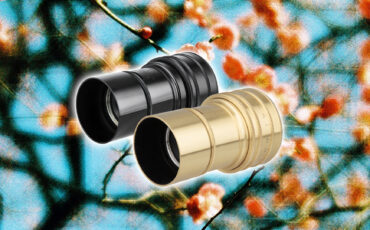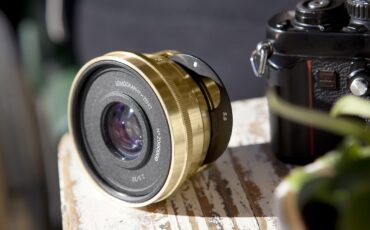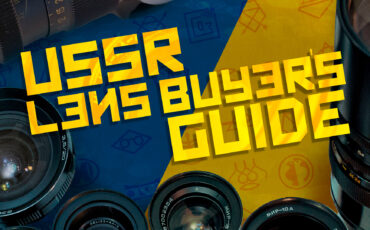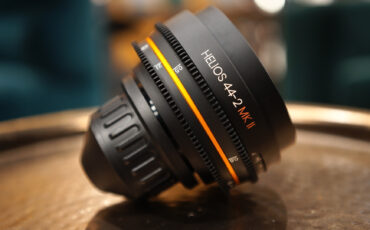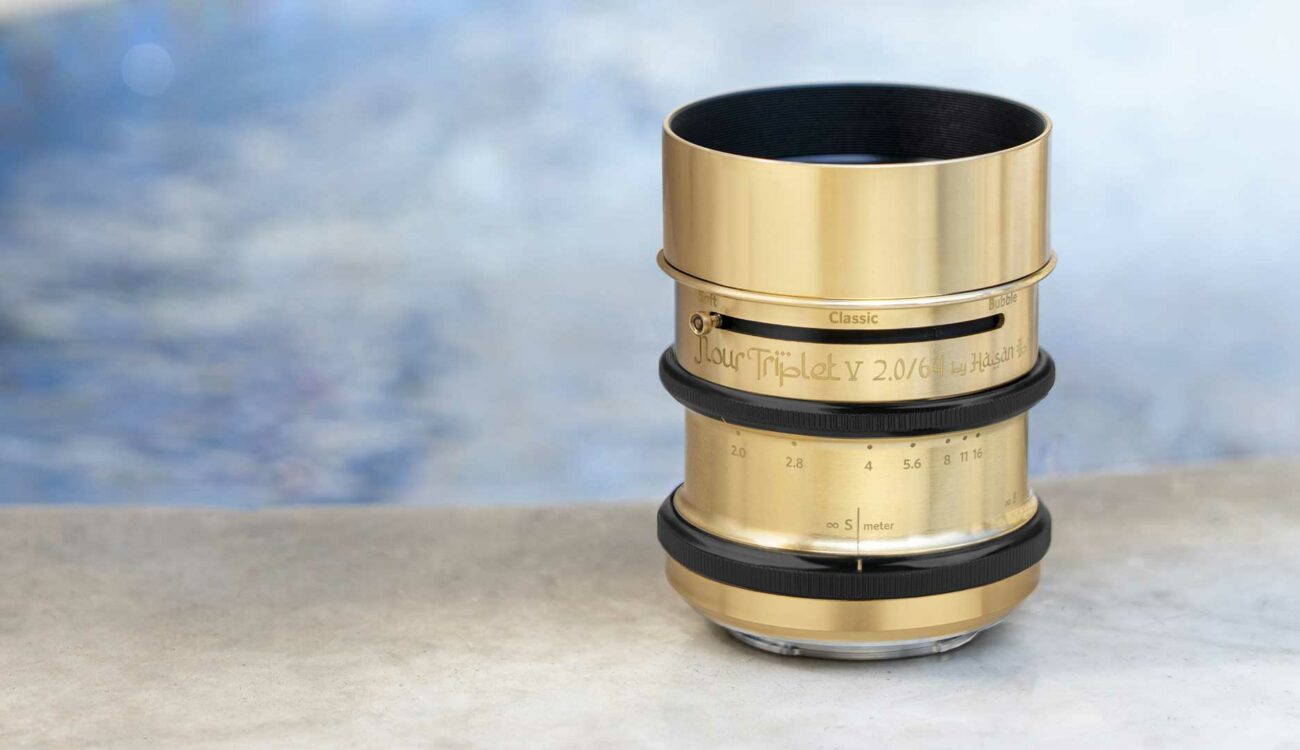
Lomography launches yet another historically inspired lens – the Nour Triplet V 2.0/64 Bokeh Control Art Lens. The optical design is a take on the classic triplet but with a twist – manual control over some unique characteristics such as sharpness and bubble bokeh.
The Nour triplet is a 64mm f2.0 FF mirrorless lens. it will come in three different mounts – Canon RF, Sony E, or Nikon Z. The Nour will be available in two different flavors: Black anodized aluminum or golden-brown brass (with black control rings). Three control points are onboard: A focus ring, an aperture ring, and a sliding knob to control spherical aberrations resulting in control over the general sharpness (and softness) of the subject in focus, and the bokeh rendering, from soft-edged so “bubble bokeh”.
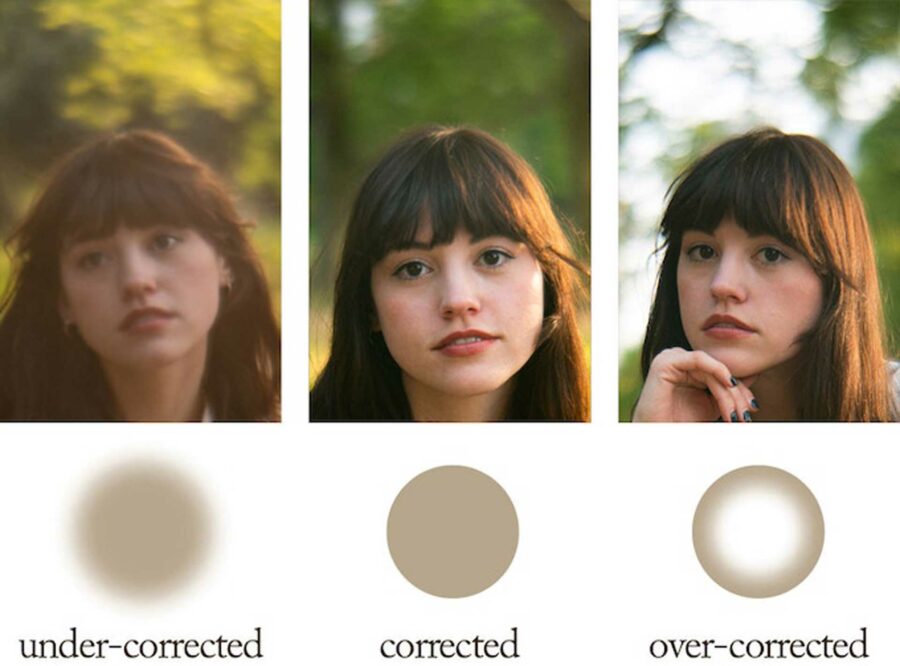
Additional control over bokeh rendering is achieved by rear-mounted drop-in filters. They will turn your everyday “bokeh-balls” into stars, hearts, and other funky shapes. Installation requires detachment of the lens and unscrewing a rear element, but is a simple and completely user-friendly mechanism.
The front filter thread is 55mm, and the minimum focus distance is 60cm (so no macro capability). 15 blades of aperture will take you from f2.0 to f16. The weight is 620g (1.3 lbs) for the brass version and 395g (0.87 lbs) for the aluminum lens.
It’s not a bug, it’s a feature!
The Nour takes an alternate path, taking what is considered optical defects and turning them into a desirable effect. This path gained popularity in recent years as more and more cinematographers and photographers try to replicate some nostalgic essence in their imagery. We’ve seen several manifestations of this trend, including the rehousing of old lenses, newly manufactured classic designs, or just adapting classic lenses to modern cameras. This trend may be discarded as a hipster whim, a gimmick, or just plain kitsch but there are actually some relevant arguments supporting it:
Modern lenses are just too perfect
High-resolution digital sensors provide an amazing level of fine detail, way finer than film. As sensors have gotten better, they’ve exposed optical flaws which have created an incentive for lens manufacturers to improve them and create lenses that will out-resolve the sensor. But something was lost along the way. It may be no more than our nostalgic yearns but cinema is a nostalgic medium. The clinical look that modern lenses provide may not align with some of our expectations, and we’ll soon discover that softening an image isn’t fixed that easily in post.
High-end cinematic lenses are pricy, to say the least
Even a single high-end cinema lens from ARRI, ZEISS, Schneider, Cooke, or Canon will set you back a significant sum. A cinematic set will cost as much as a nice car or even a nice house. In stark contrast – a full vintage FF prime set can be purchased for hundreds or a couple of thousands of dollars/euros. As cameras drop in price and a broader crowd enters the halls of filmmaking, affordable optics are required. This, in turn, changes the way young filmmakers perceive the “cinematic look” as more projects are filmed using affordable optics
The Secrets of Optics
Small screens, loose standards
Most videos taken these days will never see the silver screen. Most will be viewed on desktop monitors, laptops, tablets, and mobile phones. The viewing method somewhat offsets the high optical demands of high-quality sensors and emphasizes the “total look”, in which vintage lenses excel.
Nour – Light and Knowledge
With its Nour triplet Lomograpy paying homage to Hasan Ibn al-Haytham, a pioneering scientist, mathematician, and optical engineer, Ibn al-Haytham was born in Basra (in modern-day Iraq) circa 965.
Referred to as “the father of modern optics”, he made significant contributions to the principles of optics and visual perception in particular. His most influential work is titled Kitāb al-Manāẓir (Arabic: كتاب المناظر, “Book of Optics”), written during 1011–1021, which survived in a Latin edition. The works of Alhazen were frequently cited during the scientific revolution by Isaac Newton, Johannes Kepler, Christiaan Huygens, and Galileo Galilei.
(Wikipedia)
Some more info about Ibn al-Haytham may be found here.
Though the link between Ibn al-Haytam’s monumental work to the lens is rather loose, it’s nice to see a manufacturer honoring the people who started it all.
Who is the Lomography Nour Triplet for?
If you are unafraid of complete manual control, not obsessed with resolution charts, and want to take the adventurous path, manipulating aspherical aberrations, aperture shape, and more – The Lomography Nour Triplet 64 f2.0 might be the lens for you. If you prefer your lenses to be spot-on, sharp, consistent, or provide repeatable output, you might want to look elsewhere. The Nour will provide a distinct user experience and unique rendering that may complement certain styles, and unlike other vintage (or “vintage”) lenses will enable a level of control over those special characteristics.
Alternatives to the Lomography Nour Triplet
Alternative lenses can be split into two main groups: comparable focal length / FOV or comparable rendering. Though every “special” lens is unique in its own way, we will bundle this unsharp bunch together. There is of course the Petzval, one of the earliest lenses in this trend of remaking old glass. Meyer Optik Gorlitz also makes some nice renewed classics, and there’s LensBaby that takes a slightly different (and blurrier) path. And of course the scores of actual vintage lenses filling up on eBay, etc.
Though not a very popular focal length, we’ve seen some 65mm lenses emerging in recent years. SIGMA has two 65’s – a large Cinema 65 T1.5 and a compact stills-oriented 65 f2.0. IRIX recently announced their own Cinematic 65 T1.5 and there’s the Voigtlander 65 f2.0 Macro lens for e-Mount and Z-Mount.
Pricing and availability
A pledge to campaign on the “early bird” offers will grant you a 25% discount on future MSRP.
At the end of every crowdfunding-related article, we remind you to please be aware of the risks when backing a project on a crowdfunding platform. Also, please read the platform’s use and remember there can be significant delays when delivering the product. Some projects don’t get delivered at all.
The Aluminum version will cost $335 in either RF, E, or Z mount.
The brass version will cost $410 in either RF, E, or Z mount.
Both include a compatible hood and cap, a cleaning cloth, and a photo book.
So will a lens like the Nour triplet find its place in your bag? Can you see creative potential or will you discard it as just another gimmick? Let us know in the comments!




